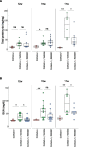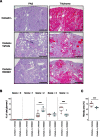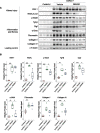PPAR δ Agonism Ameliorates Renal Fibrosis in an Alport Syndrome Mouse Model
- PMID: 36657027
- PMCID: PMC10103270
- DOI: 10.34067/KID.0006662022
PPAR δ Agonism Ameliorates Renal Fibrosis in an Alport Syndrome Mouse Model
Abstract
Key Points:
A peroxisome proliferator-activated receptor δ agonist, REN001, ameliorates kidney dysfunction in a mouse model of Alport syndrome.
REN001 suppresses glomerular injury and renal fibrosis.
REN001 decreases the levels of inflammation- and fibrosis-related proteins.
Background: Alport syndrome is a genetic kidney disease caused by mutation in any of the COL4A3, COL4A4, or COL4A5 genes encoding the type IV collagen α3, α4, and α5 chains. Defects of type IV collagen α3α4α5 cause glomerular basement membrane abnormalities and lead to defects in glomerular filtration and ESKD. Treatment with angiotensin-converting enzyme inhibitors (ACEis) dramatically slows disease progression but does not stop progression to renal failure. Therefore, novel therapeutic options with different modes of action from ACEis are needed. Peroxisome proliferator-activated receptor (PPAR) δ agonists have shown renoprotective effects in several acute kidney injury mouse models. In this study, we investigated the effects of a potent and selective PPARδ agonist, REN001 (formerly HPP593), in a mouse model of Alport syndrome.
Methods: We administered REN001 from the early stages to the late stages of disease by once daily intraperitoneal injections.
Results: REN001 treatment halved proteinuria at the late stages of disease in Col4a3−/− mice. BUN levels were also decreased, and histological and molecular analyses showed that REN001 ameliorated renal inflammation and fibrosis.
Conclusions: These results indicate that REN001 slows kidney disease progression in Alport mice. REN001 has a different mechanism of action from ACEis, so we, therefore, hypothesize that combining the two treatments may show additive effects to attenuate renal injury and slow progression to renal failure.
Trial registration: ClinicalTrials.gov NCT01613118.
Figures





Comment in
-
Targeting Fibrosis Pathways in Alport Syndrome-Is it Too Late?Kidney360. 2023 May 1;4(5):580-581. doi: 10.34067/KID.0000000000000136. Epub 2023 May 25. Kidney360. 2023. PMID: 37229728 Free PMC article. No abstract available.
References
Publication types
MeSH terms
Substances
Associated data
LinkOut - more resources
Full Text Sources
Medical

